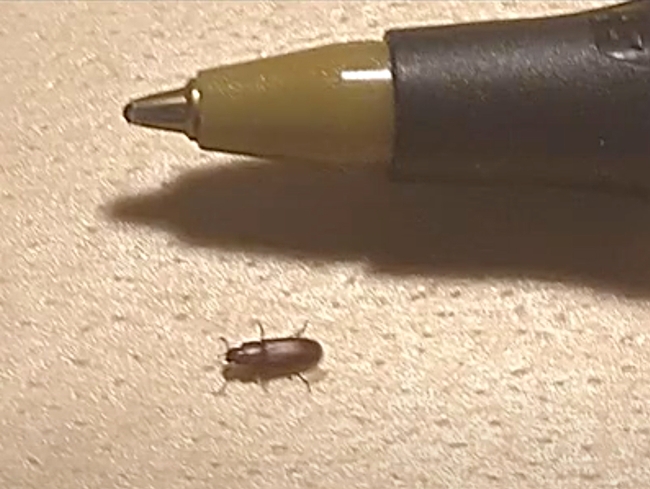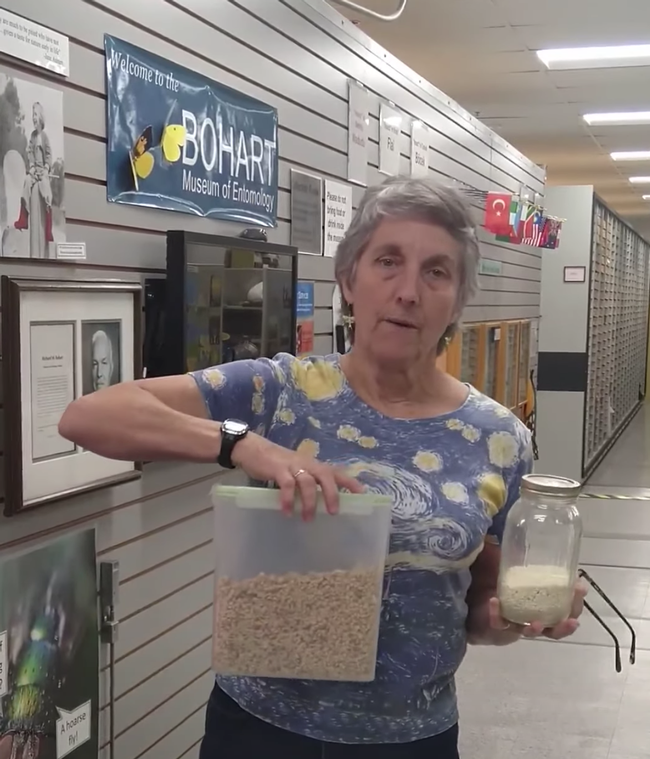
No, this is not a historical reference to that famed rock band from Liverpool.
These are real beetles. The insects.
Lynn Kimsey, director of the UC Davis Bohart Museum of Entomology and a UC Davis distinguished professor of entomology, is fielding scores of calls--some panicked calls--about a beetle invasion in Davis.
In response, Kimsey has just created a public service announcement (PSA) of what they are (they are red flour beetles) and what folks should do and not do (don't panic).
"We have had a lot of reports and panic about small beetles invading people's houses in Stonegate and other parts of Davis," she relates on YouTube, "and just thought we ought to just clear the air a little bit with this and tell you a little about these guys. So as you can see they are very tiny. These are grain beetles. They are called the red grain flour beetle."
"They feed on dried, starchy materials," she says. "They will even occasionally feed on things like raisins, but nothing else. They are a stored product pest. They are probably coming out of field of grain--grain fields were harvested in the last month or so. So they are coming out of the fields and they are flying at night."
Kimsey points out that they "will come into homes because of the lights. Also, the north wind we had blowing for awhile that didn't help."
The fastest way to get rid of them? "Vacuum them up," Kimsey says. "Dispose of the bag. Don't spray because it won't do any good."
She also urges folks to store their flour and other grains in tight-fitting lidded plastic containers, which "will prevent beetles as well as meal moths and things like this from getting in and starting an infestation."
If you do find an infestation, Kimsey says, the "fastest way to take care of it is to either put the material that is infested in the freezer, throw it out, or put it in the sun. It is still edible. These beetles are not harmful. They don't contaminate materials, unless you don't like eating beetles."
Kimsey also acknowledges it is "quite possible to get these beetles from a product you bring in from the store."
"And that happens," she says. "It is just one of those things. So what I would say is take a deep breath. This too shall pass."
Worldwide Pest
The red flour beetles are a worldwide pest of stored products. The adults are reddish brown, about 1/8th of an inch long, and oval and flattened in shape. They attack flour, cereals, pasta, biscuits, beans, and nuts, among other items, according to Wikipedia. "The United Nations, in a recent post-harvest compendium, estimated that Tribolium castaneum and Tribolium confusum, the confused flour beetle, are "the two most common secondary pests of all plant commodities in store throughout the world."
The females of both species are polyandrous, that is, they will mate with multiple different males.
The UC Statewide Integrated Pest Management Program (UC IPM) describes the red flour beetle (see photo of the red flour beetle) as a common pantry pest.
"Pantry pests usually enter your home in an infested package of food," UC IPM says. "You might not notice these small insects until you see moths flying around your kitchen or beetles crawling in your food. Get rid of these pests by removing infested food, tightly sealing stored dry food, and thoroughly cleaning the area."
UC IPM offers these tips on its website for preventing a pantry pest infestation:
- Store food in containers with tight-fitting lids, not plastic bags.
- Store bulk goods like pet food in airtight containers.
- Keep certain infrequently used food like flours, spices, and grains in a freezer if possible.
- Wash old containers before filling them with new food.
- Don't mix old and new food together.
- Clean shelves, bins, and other food storage areas regularly.
Meanwhile, listen to Professor Kimsey's PSA on YouTube and check out the images.
The beetles. They're not just coming. They are here.
Attached Images:
